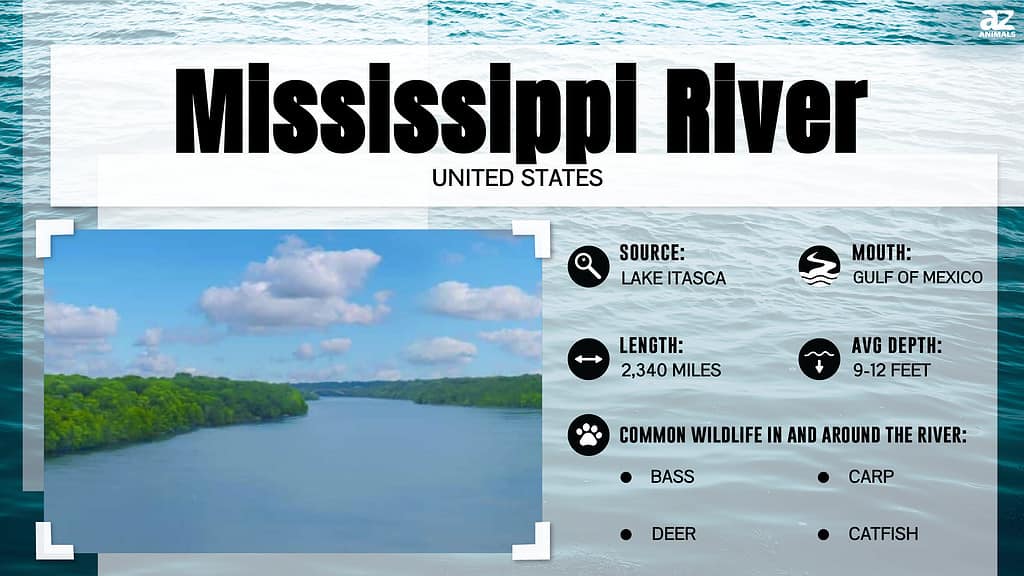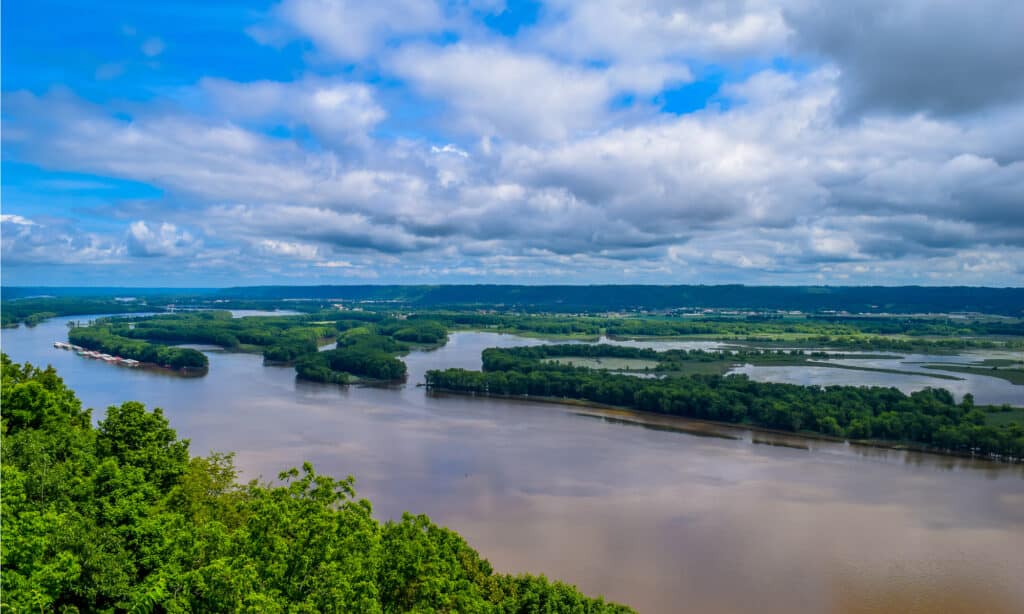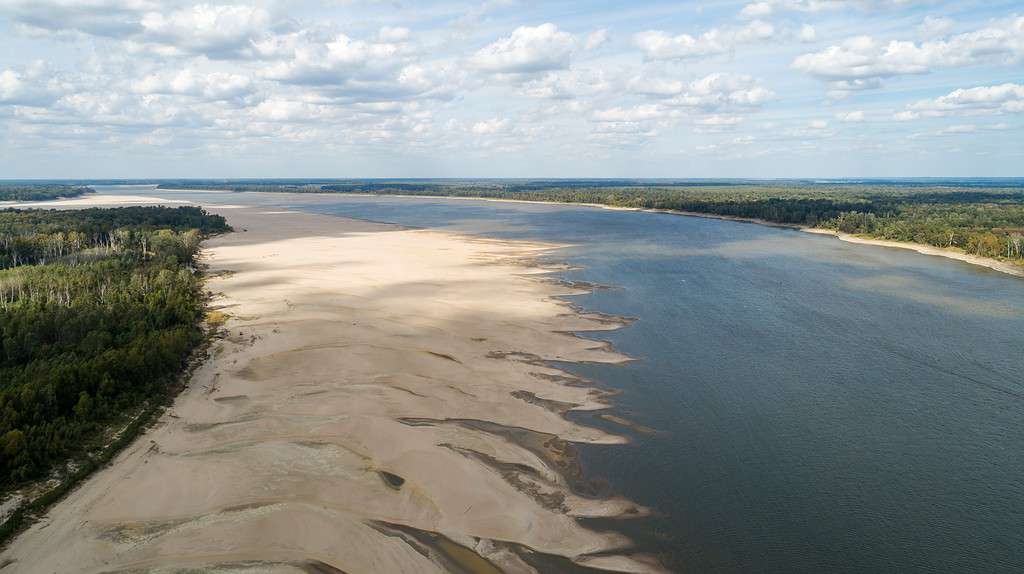The Mississippi River is better known for catastrophic floods than low points. However, due to climate change and building works, its water level has reached critical levels. At one point, its level was so low it prevented barge navigation. Here’s when the Mississippi River was at its lowest point ever.
But first, let’s take a quick overview of the Mississippi River because it’ll help us understand how and why low water levels are a problem, not only for us but for the environment, ecosystem, and animals, too.

All About the Mississippi River
The 2,340-mile-long Mississippi River bisects almost all of the U.S. from its source in Lake Itasca, Minnesota, to Louisiana in the Gulf of Mexico, where it discharges into the sea. The Mississippi River runs through or touches the borders of 10 states. They are Minnesota, Wisconsin, Iowa, Illinois, Missouri, Kentucky, Tennessee, Arkansas, Mississippi, and Louisiana.
The Mississippi is known by several names, including Old Man River, Old Blue, and The Big Muddy. Native Americans called it Michi Sepe, which means “great river” or “father of waters.”
It played a crucial part in the early exploration of the States. As America grew, the mighty Mississippi was fundamental to the Industrial Revolution, allowing freedom of movement and sustaining settlers with fish, shellfish, and meat from animals drawn to its waters.
Today, 18 million people rely on Old Blue for drinking water. It’s a critical waterway to the Midwest because it shifts 175 million tons of cargo each year. Thirty-five thousand people are employed in relation to the Mississippi River. It’s a vast animal ecosystem, plus a migratory corridor for over 300 bird species. Its widely underestimated influence is huge, and that’s why low water levels on the Mississippi River are a problem.

The Mississippi is known by several names, including Old Man River, Old Blue, and The Big Muddy.
©iStock.com/Kruck20
When Was the Mississippi River at the Lowest Point Ever?
The Mississippi River was at its lowest point ever on October 18, 2022. The water level dropped to a record low of – 10.81 feet at Memphis, Tennessee. Water levels were so low that boats experienced problems navigating the river between Cairo, Illinois, and Baton Rouge, Louisiana. It was the lowest point the Mississippi River has ever reached since records began in 1954.

The
Mississippi River runs through or touches the borders of 10 states
.
©EyeTravel/Shutterstock.com
Why Was It So Low?
Fall is a dry period, but in 2022, a flash drought in the central U.S. made life much worse. Drought conditions increased evaporation, which lowered the river level. It also meant that rain did not refill the river.
The Mississippi River drains over 1,000,000 square miles of land. The 2022 drought affected a huge area of the U.S., and this meant less drainage water joined its flow.
The tributary river levels contributed too. Any river that flows into the Mississippi River contributes to its water volume. The Mississippi River has 250 tributaries, including major rivers such as the Ohio and Missouri Rivers. Its tributaries also experienced water level drops during the period. This meant less water flowed into the Mississippi.

The 2022 drought affected a huge area of the U.S., and this meant less drainage water joined its flow.
©Justin Wilkens/Shutterstock.com
Is the Mississippi Drying Up?
The Mississippi River was at its lowest point ever in 2022 when it dipped to – 10.81 feet, but it’s dropped before. Here are the Mississippi River’s historically low water levels.
- – 6.70 feet on February 4, 1964, at The Greenville, Mississippi
- – 6.10 feet on January 16, 1940, at St. Louis
- – 10.70 feet on February 10, 1937, at Memphis, Tennessee
Scientists attribute low water levels to higher temperatures and less rainfall caused by climate change.
In 2020, scientists ran an experiment to measure soil moisture data. Tree rings measure drought. Wide tree rings indicate enough moisture and good growth, whereas thin rings indicate a dry year with little growth. Tree rings indicated that, at the time, the current dry period was the second-worst dry period in 1,200 years. The worst-ever dry period occurred in the late 1500s.
However, the dry years of 2021 and 2022 exceeded the 1500’s drought length. This means the last 22 years are the driest in 1,200 years. It’s not surprising that the great rivers are shrinking. In fact, in 2022, China’s Yangtze River and the European Rhine both reached an all-time low.
Why Does It Matter?
When the Mississippi River loses water volume, it impacts in several ways.
Agricultural Exports
Much of the Mississippi River is dredged, plus 29 locks and dams run its length to allow barges and rivercraft easy passage. When river levels drop, it means the deep shipping channels shrink. In turn, fewer barges can get through. Around 92% of agricultural exports, including wheat and corn, are distributed via the Mississippi River. Fewer foodstuffs on the market increase prices and raise the cost of living.
If river levels keep falling, extra dredging will help keep shipping lanes open, but this is expensive, with higher costs passed onto consumers.
In 2022, over 2,000 backed-up barges waited in the Mississippi River for a turn to navigate the remaining deep channels.
Drinking Water Contamination
Some experts believe that low river water levels allow saltwater contamination to break through the Gulf of Mexico. The freshwater mighty Mississippi River provides 18 million people with clean drinking water. Army Corps Engineers are already building structures to block saltwater contamination.
Ecosystem Devastation
The National Park Service states that 160 fish species live in the Mississippi River. Three hundred species of migratory birds use it to navigate their migrations, and over 145 reptiles and amphibians species inhabit the banks of the Upper Mississippi River alone. Couple that with the vast number of mammals such as bears, deer, otters, and beavers that rely on its water, and an ecological disaster unfolds. Hundreds, if not thousands, of species use the Mississippi River for water, food, habitation, and migration routes.

Some experts believe low river water levels allow saltwater contamination to break through the Gulf of Mexico.
©luchschenF/Shutterstock.com
Why Does the Mississippi River Flood?
The Mississippi River reached its lowest point in 2022, but it also experienced regular flood events. Here’s why:
Extra prolonged and heavy rainfall: the Mississippi River drainage basin is so large, over 1,000,000 miles, that water joins its flow from vast distances. Extra rain in concentrated amounts bursts its banks.
Snow melt: Snowmelt annually fills the Mississippi River with surges of freshwater.
Levees, locks, and dams: Floodwater management structures created over the past decades have altered the mighty Mississippi’s flow. They save some areas from floods, but excess water has to burst somewhere. This means that while some areas are safe from flooding, other areas receive huge volumes of water.
Historically, the Mississippi River has frozen, too. At the end of the 19th and beginning of the 20th century, parts of the river froze solid enough to hold human weight. In St Louis, it froze ten times between 1831 and 1938. However, it’s not happened since the Alton Lock and Dam’s constructioned. It’s because we can manipulate river flow to stop ice from stacking up.

Heavy rainfall in the summer of 1926 caused the Mississippi River to flood for several months in 1927.
©Everett Collection/Shutterstock.com
Quick Recap: When Was the Mississippi River at the Lowest Point Ever?
The Mississippi River was at its lowest point ever in October 2022. In Memphis, Tennessee, the Mississippi River dropped to – 10.81 feet.
Levels were so low that commercial barges struggled to stay afloat. Two thousand barges backed up along the river, waiting for a turn to pass in the deepest channels.
Experts believe the lowest point since the record began happened due to a flash drought. This meant less rainwater fell directly into the Mississippi and its tributary rivers. Warm temperatures contributed to existing river water evaporation, and because the drought affected a huge area, the Mississippi River drainage basin was drier.
Scientists conducting soil moisture experiments believe we are in the driest weather period for 1,200 years. If this pattern continues, we can expect to see further river volume drops. It’s entirely possible the -10.81 feet lowest point will drop even lower in the near future, despite the regular devastating flood events.
The photo featured at the top of this post is © Justin Wilkens/Shutterstock.com
Thank you for reading! Have some feedback for us? Contact the AZ Animals editorial team.






